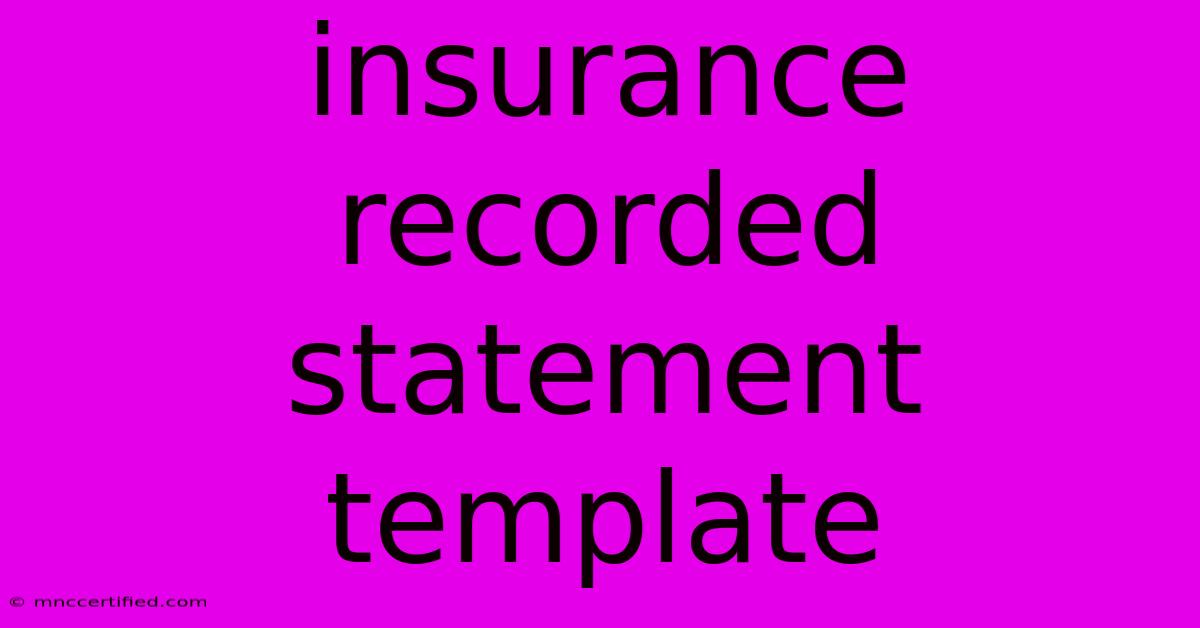Insurance Recorded Statement Template

Table of Contents
Insurance Recorded Statement Template: A Comprehensive Guide
An insurance recorded statement is a crucial document in the claims process. It provides a detailed account of the events leading to an insurance claim, ensuring accuracy and transparency throughout the investigation. This article provides a comprehensive guide to creating an effective insurance recorded statement template, along with tips to ensure its usefulness in your claims process.
Understanding the Importance of an Insurance Recorded Statement
An insurance recorded statement serves several vital purposes:
- Documentation: It serves as a detailed record of the incident, including the date, time, location, and key details.
- Accuracy: It helps ensure that the information provided is accurate and consistent.
- Clarity: It presents a clear and concise account of the events, minimizing ambiguity.
- Transparency: It fosters trust and transparency between the insured and the insurance company.
Essential Elements of an Insurance Recorded Statement Template
Your insurance recorded statement template should include the following core elements:
1. Header:
- Claim Number: This is the unique identifier for the claim.
- Policyholder Information: Include the policyholder's name, address, contact information, and policy number.
- Date and Time: Record the date and time the statement is being taken.
- Interviewer Information: Include the name and contact information of the person taking the statement.
2. Incident Details:
- Date and Time of Incident: Clearly state the date and time of the incident.
- Location of Incident: Provide the exact location where the incident occurred.
- Nature of Incident: Briefly describe the type of incident (e.g., accident, theft, fire).
- Parties Involved: List all individuals involved in the incident, including their contact information.
- Witnesses: Include any witness names and contact information, if applicable.
3. Detailed Description of the Incident:
- Chronological Order: Present the events leading up to, during, and after the incident in a chronological sequence.
- Specifics: Provide detailed descriptions of the event, including relevant facts, actions taken, and observations made.
- Photographs and Documentation: Include space to note any photographs, videos, or other documentation related to the incident.
4. Additional Information:
- Injuries or Damages: Describe any injuries sustained or damages incurred as a result of the incident.
- Medical Treatment: Include details of any medical treatment received.
- Previous Claims: Ask if the policyholder has filed any previous insurance claims.
- Other Relevant Information: Provide space for any other relevant information that may be pertinent to the claim.
5. Declaration and Signature:
- Statement Accuracy: Include a declaration stating that the information provided is true and accurate to the best of the policyholder's knowledge.
- Signature: Provide space for the policyholder to sign and date the statement.
Tips for Creating a User-Friendly Template
- Clear and Concise Language: Use simple and easy-to-understand language to ensure everyone can comprehend the information.
- Logical Flow: Organize the template with a clear and logical structure.
- Professional Appearance: Choose a professional and legible font.
- Space for Notes: Leave adequate space for the interviewer to record additional notes.
- Digital and Printable Formats: Offer the template in both digital and printable formats for convenience.
Optimizing Your Insurance Recorded Statement Template for SEO
- Target Keywords: Identify relevant keywords that people might use when searching for this type of template.
- Title and Meta Description: Optimize the title and meta description to include relevant keywords.
- Structured Data: Use structured data markup to enhance the visibility of your template in search results.
- Internal Linking: Link to other relevant content on your website to increase user engagement.
- Social Media Promotion: Share your template on social media platforms to reach a wider audience.
Conclusion
A well-designed insurance recorded statement template is crucial for accurate and efficient claims processing. By following these tips and including the essential elements, you can create a template that is both user-friendly and effective. Remember to consider SEO optimization strategies to improve your template's online visibility and reach.

Thank you for visiting our website wich cover about Insurance Recorded Statement Template. We hope the information provided has been useful to you. Feel free to contact us if you have any questions or need further assistance. See you next time and dont miss to bookmark.
Featured Posts
-
Shaws Century Test Debut Brilliance
Nov 10, 2024
-
Exploding Shower Door Insurance Claim
Nov 10, 2024
-
Pete Wicks The Most Iconic Strictly Dance
Nov 10, 2024
-
Real Madrid Suffers Seven Minute Injury Setback
Nov 10, 2024
-
Does Erie Insurance Cover Rental Cars
Nov 10, 2024